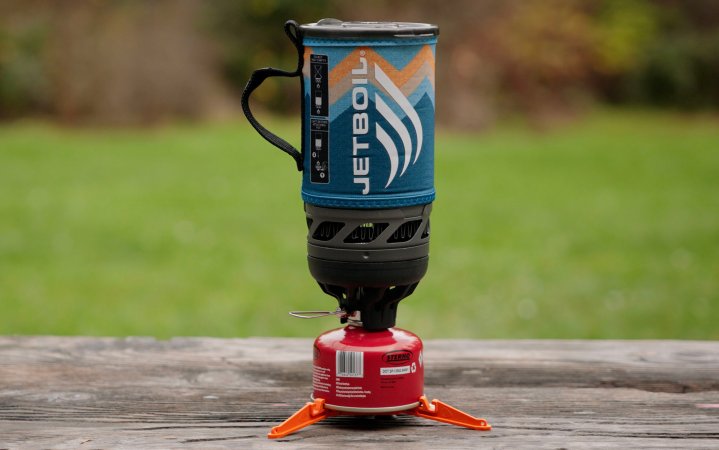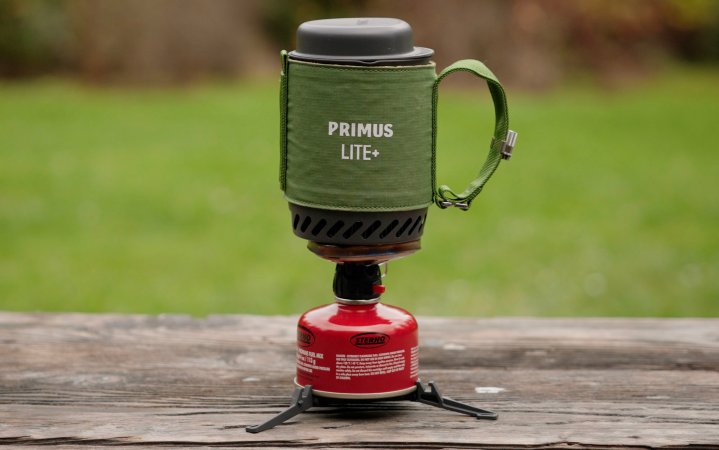We may earn revenue from the products available on this page and participate in affiliate programs. Learn More ›
The JetBoil Flash has long been considered one of the most efficient backpacking stoves around. Unlike other, smaller options, which are vulnerable to wind, rain, and snow, the integrated design of the JetBoil Flash connects the pot and stove to protect the flame from all manner of elements. But JetBoil has some competition: the MSR Windburner and the Primus Lite+. To find out once and for all, which is the best of the best, I put all three stoves through a head to head test. Here’s how it turned out:
Watch the Test in Action
How I Compared the JetBoil Flash, MSR Windburner, and Primus Lite+
The main advantage of an integrated canister stove is that it can boil water quickly, so I focused my testing on how different weather conditions affected each stove’s performance. To create a baseline, I first looked to see how long it would take to boil two cups of water in a completely windless environment (my garage). Then I took the three stoves to a nearby park for a better understanding of real-world performance. To help simulate a windy environment, I brought along one of the best camping fans. On high, this fan created a steady breeze of 10 miles per hour.

Like with my baseline test, I timed how long it took each stove to boil two cups of water. I also used a completely fresh fuel canister for each stove, which weighed 7.5 ounces to start. After each test, I weighed each fuel canister to see how much fuel it had used. I additionally tested the stated weight of each integrated canister stove against what was stated by the manufacturer.
| Stove System | Price | Capacity (in Liters) | Measured Weight | Boil Time (Windless) | Boil Time (10 mph Wind) | Fuel Used (10 mph Wind) |
|---|---|---|---|---|---|---|
| JetBoil Flash | $130 | 1 | 13.9 oz | 2:26 | 5:58 | 0.5 oz |
| MSR Windburner | $190 | 1 | 16.6 oz | 2:11 | 2:40 | 0.3 oz |
| Primus Lite+ | $130 | 0.5 | 14.8 oz | 4:04 | 13:20 | 0.7 oz |
In addition to the above testing criteria, I also took price and ease of use into consideration when determining the best overall integrated canister stove.
Best Integrated Canister Stoves: Reviews & Recommendations
Best Overall: JetBoil Flash
Pros
- Great performance during testing
- Can be paired with a skillet (sold separately) for backcountry gourmets
Cons
- Piezo igniter doesn’t work
- Not the best performance
Key Features
-
Price:
$130 -
Capacity:
1 liter - Includes piezo igniter
Test Results
-
Boil Time in Windless Conditions:
2 minutes, 26 seconds -
Boil Time in 10 mph Wind:
5 minutes, 58 seconds -
Fuel Used in Windy Conditions:
0.5 ounces -
Weight:
13.9 ounces (measured), 13.1 ounces (manufacturer spec)
When it comes to value and versatility, the JetBoil Flash was unmatched. While its boil times (2:26 in a windless environment and 5:58 in a 10 mph wind) weren’t quite as impressive as the MSR Windburner’s, it costs almost a third less and is a couple of ounces lighter. Unless you’re heading out for two weeks or more into the backcountry — where the weight savings on fuel would really start to add up — the JetBoil Flash is going to go easier on both your wallet and your pack weight.
Read Next: The Best Backpacking Stoves
While the piezo igniter failed to work during my test, that wasn’t a surprise. Backpackers have known for years that these features are convenient when they work, but are so unreliable that you will always need to bring backup matches or a lighter (which, really, you should be anyway). That being said, there were other features on the JetBoil Flash that I appreciated. It was easy to tell when the stove was lit, and I had no problem attaching the pot to the stove. While I typically stick to boiling water for freeze-dried meals when I’m out, I appreciate that gourmets have the option to use a skillet (sold separately) when they want to attempt something more ambitious. Finally, I enjoyed the aesthetics of the heat-reactive flame logo on the side, which provides added confidence that, yes, your backpacking stove is heating up your water.
Fastest Boiling: MSR Windburner
Pros
- Fastest boiling stove I’ve used
- Excellent performance in windy conditions
- Very fuel efficient
Cons
- Very fuel efficient
- Heavy
Key Features
-
Price:
$190 -
Capacity
1 liter - Does not include a piezo igniter
Test Results
-
Boil Time in Windless Conditions:
2 minutes, 11 seconds -
Boil Time in 10 mph Wind:
2 minutes, 40 seconds -
Fuel Used in Windy Conditions:
0.3 ounces -
Weight:
16.6 ounces (measured), 15.3 ounces (manufacturer spec)
In terms of raw performance, the MSR Windburner blew the competition out of the water, and it wasn’t even close. It boiled water in under three minutes, twice as fast as the JetBoil Flash and five times as fast as the Primus Lite+. If you regularly face challenging environments, then the Windburner is the stove you want. It also used slightly less fuel than the JetBoil Flash.
Unlike the JetBoil Flash, the MSR Windburner is only designed to boil water, so if you have other culinary ambitions, this might not be the right stove for you.
Best Ignition: Primus Lite+
Pros
- Only stove in my test that could be lit in strong winds
- Includes some features that will appeal to rock climbers
Cons
- Worst performing stove in my test
- Smaller capacity than the JetBoil Flash or MSR Windburner
Key Features
-
Price:
$130 -
Capacity:
Half a liter - Includes piezo igniter
Test Results
-
Boil Time in Windless Conditions:
4 minutes, 4 seconds -
Boil Time in 10 mph Wind:
13 minutes, 20 seconds -
Fuel Used in Windy Conditions:
0.7 ounces -
Weight:
14.8 ounces (measured), 14.2 ounces (manufacturer spec)
While the Primus Lite+ did not perform to the level of the MSR Windburner or Jetboil Flash, there was one area where it shone: ignition. While I had to move the other two stoves out of the wind to actually light them, the design of the Primus Lite+ allowed it to immediately ignite in full wind, first try. This in large part because its piezo (which actually worked) and the burner itself are recessed in the stove, protecting them from the wind.

Unfortunately, that was where the Primus Lite Plus’s advantage ended. In testing, this stove took so long to boil two cups of water that I nearly gave up and ended the test early. You’ll also see in the video that I struggled at one point to correctly set the pot on the stove, as it requires a more delicate twist than the other two. I was also disappointed to see that its removable cozy was slipping down, where it could potentially be singed by the stove. Finally, it only has about half the capacity of either the MSR Windburner or the JetBoil Flash.
There are some unique features to the Primus Lite+ that are worth pointing out. The first is that the handle of the pot is designed to detach at one end so that you can reattach it as a haul handle. This allows you to suspend the entire system while you are boiling water, which would theoretically be useful for rock climbers who do not have any terra firma to put their stove on to. (Just be careful you don’t accidentally drop the stove portion when you are finished.)
That being said, this is a very limited use, as it would involve a multi-day climb, and I was not able to find examples of it in action in this context. More functional are the three screws attached to the handle, which can be screwed into the stove itself, so that it’s compatible with other pots and pans. Just be careful you don’t accidentally burn yourself on these when you are using the Primus Lite+ in its regular configuration, as the three screws are stored on the handle and can heat up and be uncomfortable to the touch.
How to Choose an Integrated Canister Stove
Consider Your Typical Backpacking Destination
Integrated canister stoves shine in challenging environments. While you might struggle to boil even a cup of water with a simple canister stove (wasting untold fuel in the process) the best integrated canister stoves will have your coffee or food warmed up in no time. If the conditions you camp in are moderately challenging — some wind, but not enough to challenge the best backpacking tents — then the JetBoilFlash will provide excellent results. If you consistently find yourself cooking the best backpacking food in exposed, unforgiving terrain, then look at the MSR Windburner.
Price
While all the integrated canister stoves I looked at were fairly pricey, it’s worth keeping in mind that they include your cooking pot, which is something you otherwise would need to purchase separately. That being said, it was clear from my testing that, given the performance of each unit, the JetBoil Flash was the best value of all the stoves I looked at.
Potential Fuel Usage
Depending on how often you go backpacking, and for how long, a more expensive integrated canister stove system can actually save you money over the long haul. That’s because the fuel savings can really start to add up over time, with stoves like the JetBoil Flash and the MSR Windburner needing half the amount of fuel that other backpacking stoves would need in the same conditions, and sometimes even less than that.
FAQs
In testing, I was impressed at how favorably the MSR Windburner compared to the JetBoil Flash, albeit at a higher price point.
You can use any isobutane fuel in integrated canister stoves, as well as with any of the best backpacking stoves.
Depending on the conditions you are in and what you are doing, you can expect a small fuel canister to last one person between four and five days.
Final Thoughts
I was impressed by how well the best integrated canister stoves I tested performed in challenging conditions. If you often find yourself battling the wind to get water boiled, then making the switch to an all-in-one system could save you time and money over the long haul.




